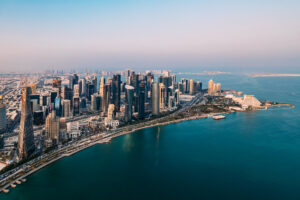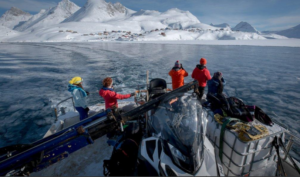The Lai brothers conquer Nepal’s Mera Peak
Syazwani Hj Rosli & Rokiah Mahmud–
Borneo: The Lai brothers trek up the mountain in single file formation while being led by their guide.
Three of the Lai brothers unfurl the Brunei Darussalam flag at the peak of the mountain, 6,654 metres above sea level.
A month ago, five brothers from the Lai family successfully trekked up to the summit of Mera Peak, one of the highest mountains in the world. The mountain which lies in the Himalayan region of Nepal, stands at about 6,654 metres above sea level.
The five brothers – George Lai (55), Gabriel Lai (51), Clement Lai (50), Jerome Lai (48) and Cyril Lai (42) – whose passions include venturing through jungles and mountain trekking have already tackled much of what Southeast Asia has to offer, such as Mount Kinabalu.
The brothers had to train for about two years to maintain a high level of fitness, both physically and mentally, prior to their Mera Peak expedition.
The brothers’ self-sponsored journey began on October 16, 2012. They made the trip via Unique Trekking, an agency that offers trekking packages which assisted them in realising their 12-day-and-eight-hour trek up the undulating mountain range.
The day before their expedition, they were greeted on arrival by a representative of Unique Trekking, Mr Khum Subedi, who informed them of the mountaineering equipment and necessities that they would need to purchase.
The first few days of the expedition saw the Lai brothers pass by Pujya Village, Jiri Village, Sibuje Village and the Dutkunda Mountain.
It did not take long before they began experiencing extreme conditions with temperatures reaching minus 25 degrees Celsius and lower. Despite low and limited oxygen levels, which triggered altitude sickness, the brothers pushed onwards towards achieving their goal – especially after taking into account the fact that their porters travelled while shouldering over 70 kilogrammes of equipment and supplies, in addition to their ability to navigate the mountain trails in the dark.
The brothers made pit-stops at several camps such as Chatarapuk and Khote, where they enjoyed the luxury of a hot shower before trekking for another six days to the summit. While resting body and mind at the pit-stop camp, one of the Lai brothers, Cyril celebrated his 48th birthday and was surprised to receive a cake during the pit stop.
Restlessness and agitation began to set in as the brothers began suffering painful headaches, one of the symptoms of altitude sickness resulting from sleepless nights. The porters gave them raw garlic to chew as a remedy to ease the pain, which alleviated the pressure only slightly.
Upon reaching Khare, the brothers began rubbing garlic on their foreheads in addition to chewing it as they started experiencing feelings of nausea. They were then slowed down considerably due to a blinding snowstorm that raged for hours, before rappelling down a section of the mountain to reach another camp.
Once the brothers reached the summit, they pushed onwards to reach the peak but the journey at this stage was done very slowly due to the thin levels of oxygen that made every step exhausting.
Finally, they completed their ascent with Cyril stopping at 6,065 metres, Jerome at 6,100 metres, while George, Gabriel and Clement along with their guide, Lakpa Sherpa reached the very summit together at 6,654 metres.
During the final day of the ascent, day 11, the brothers were harnessed and roped together and had to cross crevasses for hours in the blinding whiteness of their surroundings as daylight appeared. The climb progressed into short shuffles and comprised many rest breaks, but despite this, the Lai brothers planted the flag of Brunei Darussalam at the peak, marking themselves as the very first Bruneians to conquer the mountain.
The brothers expressed their hope during an interview with the Bulletin that their indomitable will would encourage a younger generation of trekking enthusiasts to follow suit, and have also proved beyond a reasonable doubt, that age is most definitely just a number and nothing more.- Borneo Bulletin weekend Nov.17















